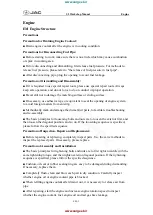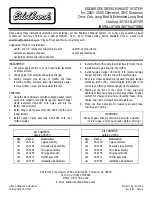
7B-19 Air Conditioning System:
Evacuation
CAUTION:
Do not evacuate before recovering
refrigerant in A/C system.
NOTE:
Once air conditioning system circuit is
opened (exposed) to atmospheric air, system
must be evacuated by using a vacuum pump.
The A/C system should be attached with a
manifold gauge set, and should be evacuated
for approximately 15 minutes.
1) Connect high charging hose (1) and low charging
hose (2) of manifold gauge set (3) respectively as
follows:
High charging hose
o
High pressure charging valve
(4) on condenser outlet pipe
Low charging hose
o
Low pressure charging valve
(5) on suction pipe
2) Attach center charging hose (6) of manifold gauge
set to vacuum pump (7).
3) Operate vacuum pump, and then open discharge
side valve (Hi) (8) of manifold gauge set.
If there is no blockage in the system, there will be an
indication on high pressure gauge (9).
In this case, open the other side valve (Lo) (10) of
the set and repair the system.
4) Approximately 10 minutes later, low pressure gauge
(11) should show a vacuum lower than –100 kPa (–
1.0 kg/cm
2
, –760 mmHg, –14.7 psi) providing no
leakage exists.
NOTE:
• If the system does not show a vacuum
below –100 kPa (–1.0 kg/cm
2
, –760 mmHg,
–14.7 psi), close both valves, stop vacuum
pump and watch movement of low
pressure gauge.
• Increase in the gauge reading suggests
existence of leakage. In this case, repair
the system before continuing its
evacuation.
• If the gauge shows a stable reading
(suggesting no leakage), continue
evacuation.
5) Evacuation should be carried out for a total of at
least 15 minutes.
6) Continue evacuation until low pressure gauge
indicates a vacuum less than –100 kPa (–1.0 kg/cm
2
,
–760 mmHg, –14.7 psi), and then close both valves.
7) Stop vacuum pump. Disconnect center charging
hose from pump inlet. Now, the system is ready for
charging refrigerant.
Checking A/C System for Pressure Leaks
After completing the evacuation, close manifold gauge
high pressure valve and low pressure valve and wait 10
minutes. Verify that low pressure gauge reading has not
changed.
CAUTION:
If the gauge reading moves closer to “0”,
there is a leak somewhere. Inspect the tubing
connections and make necessary
corrections. And then, evacuate system once
again and make sure that there are no leaks.
7
5
2
4
1
10
11
3
9 8
6
I4RS0A720014-
Summary of Contents for SWIFT RS415 2017
Page 2: ......
Page 4: ......
Page 6: ......
Page 331: ...Engine Lubrication System 1E 2 I3RH0B150001...
Page 404: ...1K 6 Exhaust System...
Page 452: ...2D 8 Wheels and Tires...
Page 464: ...3A 11 Drive Shaft Axle...
Page 722: ...5B 13 Manual Transmission Manual Transaxle Assembly Components S4RS0A5206028 I4RS0A520013...
Page 760: ...5C 14 Clutch...
Page 762: ...6 ii Table of Contents Special Tool 6C 38...
Page 812: ...6C 39 Power Assisted Steering System...
Page 860: ...7B 35 Air Conditioning System...
Page 1192: ...9L 5 Paint Coatings I4RS0A9C0004 A Apply sealant...
Page 1255: ...Prepared by 1st Ed Dec 2004...
Page 1256: ...21 mm 99500 63J00 24E 99500 63J00 24E SERVICE MANUAL VOLUME 1 OF 2 SERVICE MANUAL VOL 1 OF 2...
Page 1257: ...29 mm 99500 63J00 24E 99500 63J00 24E SERVICE MANUAL VOLUME 2 OF 2 SERVICE MANUAL VOL 2 OF 2...
















































